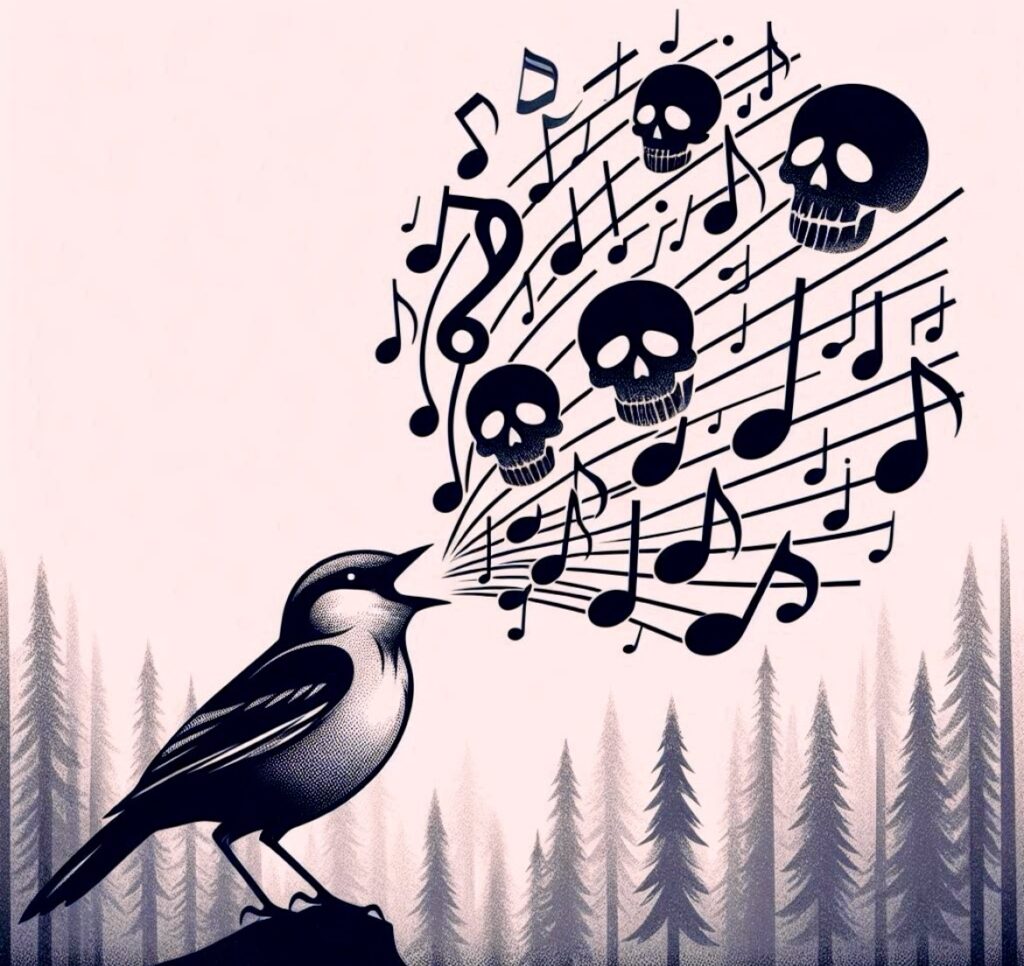DARK SONGS AND THE SOUND OF IRRATIONALITY
Storytelling is an act of translation that tasks the artist with ferrying meaning across cultural chasms to far embankments where attentive recipients can be bestowed insights into the human condition. But it is the gifted songwriter/performer who has the best chances of getting that message across in a form most graspable by the souls massing on distant shores. As a communicative art, the carefully crafted song can match the rhythms of the human heart and inspire emotions that color listeners’ interactions with the world.
Sure, the majority of works that find their way to public performance are “love songs,” and that says much about what it means to be human. But what about those musical texts that go darker, those lyric stories that dance into territories where the shadow aspect reigns supreme?
What about the dark song?
Horror narratives in all media can telescope the metaphysical intuitions of the theologian, the rational arguments of the philosopher, and the insights of the psychiatrist. But when you combine the crystalline perspicacity of the horror narrative with the charged flow of the musical form, you create art that can entice listeners to the edge of the abyss and invite them to gaze deeply into the depths of the human experience.
Of course, audiences may not like what they see. Or hear.
Perhaps that is why in the English-speaking economies only a handful of commercially prosperous musical artists have successfully forayed into the shadows without sacrificing their careers.
What those daring singers and songwriters gifted to us are lyric narratives that challenge us to consider that we are not rational masters of free will, but that the clay of our lives is forever sculpted by the hands of invisible forces both divine and profane, transcendent and immanent. Or worse, that there is no sculptor at all.
In 1964, folk artist Bob Dylan — who was awarded a Pulitzer Prize in 2008 and a Nobel Prize for Literature in 2016 — released “The Ballad of Hollis Brown,” a ballad about a farmer who murders his family and himself. The song instills horror in the listener not only through its depiction of manslaughter, but from the combined power of the lyric narrative’s metaphysical perspective and social commentary.
The composition relies upon the argument that as a species we thrive on social interaction, and Hollis Brown is a man who “lived on the outside of town.” Adding to Brown’s separation from the social community is the suggestion of a creeping dysfunctionality within the family of seven.
That hint of familial crisis is in the final line of the first stanza, which says that the farmer’s “cabin” is “falling down” — a doubling of metaphorical significance that emphasizes not only the failing integrity of the architectural structure, but of the social unit of the family. As the popular idiom attributed to Pliny the Elder states: “Home is where the heart is,” and the Brown family is losing heart.
The choices of narrative address also inject an artful and uncanny authority into the song. After the opening stanza, the subsequent nine stanzas of the song have the narrator directly addressing Brown with “You,” as if the narrator is an invisible presence inspiring the farmer toward despair. This shift bestows upon the narrator an uncanny power that is then put to a dark purpose.
The song focuses first on Brown’s inability to earn a living: “You looked for work and money/ And you walked a rugged mile.” The narrator suggests the inability to secure work may be “personal,” that the Brown homestead’s distance from the town signifies Hollis Brown’s lack of personal connections: “If there’s anyone that knows/ Is there anyone that cares?/ You prayed to the Lord above/ Oh please send you a friend/ Your empty pockets tell yuh/ That you ain’t a-got no friend.” There is no charity toward Brown from the townsfolk or his God.
The suggestion of a divine power’s intervention comes in a list of “bad luck” downturns that on a larger scale would qualify as Biblical plagues: “The rats have got your flour/ Bad blood it got your mare/ … Your grass it is turning black/ There’s no water in your well.” The Brown family is starving.
From the forest “a coyote calls,” and Hollis Brown looks at the shotgun hanging on his wall. Over the course of two stanzas the farmer goes from looking at the gun to holding it, at which point the narrator no longer directly addresses Hollis Brown.
In the final two stanzas the narrator/singer addresses the listener again, telling us: “There’s seven breezes a-blowin’/ All around the cabin door/ Seven shots ring out/ Like the ocean’s pounding roar.” Have the seven breezes as angels of death come to collect the souls of the Brown family?
Dylan’s song suggests destructive interventions by invisible forces, most obviously recognizable with the insertion of the coyote, an animal that many North American tribal cultures respect as both a trickster figure and a spiritual force connected to deaths and births. But this murder ballad is also a critique of the human community that rejected Hollis Brown and failed to intervene with any sort of assistance.
If horror can be achieved through the notion of invisible forces driving the individual toward horrendous acts, more appalling is the idea that our cruelest behaviors spring not from the hot breath of cosmic powers or the cool whispers of socioeconomic norms, but from dark spaces within our private psyches: our shadow selves.
The notion of the shadow aspect being part of the human psyche was brought into the light of intellectual respectability by the psychoanalytic tradition, beginning with Sigmund Freud’s concept of “the unconscious” and later Carl Jung’s idea of “the shadow.” The suggestion that we carry within ourselves a natural drive toward irrational and destructive behavior is anathema to thinkers who champion our species as “Homo economicus” — intelligent creatures motivated by reason rather than driven solely by emotion.
Philosophers and economists who favor the idea of humans as rational beings may experience pure horror when hearing “I Don’t Like Mondays,” a nihilistic murder ballad written by Bob Geldof and released to commercial success in 1979 by his Irish punk rock band The Boomtown Rats.
“I Don’t Like Mondays” is a lyric re-imagining of an actual sniper incident involving a 16-year-old girl who targeted children gathering on the school grounds across the street from her home. During the standoff between the shooter and the police, a local reporter telephoned the sniper and asked her why she was targeting the school. The teenager reportedly replied: “I just don’t like Mondays. … I did this because it’s a way to cheer up the day.”
The song encourages dread insofar as it questions the assumption that our technologically advanced societies are securely established upon plinths of human reason. The song achieves this assessment by ironically attaching rationality to the shooter’s facetious explanation for her violence.
The narrative opens with a technological metaphor for the human brain: “The silicon chip inside her head/ Gets switched to overload.” Silicon chips serve as conduits of the electrical signals that give life to computing devices, and in Geldof’s song the killer’s mind has abandoned its function of control and embraced an uninterrupted flow of thought. She has become a purely reactive animal, a creature of uninhibited id.
What follows from the opening line is a dialogue between the shooter and those who respond to her violence — specifically the police, the press, and her parents. It does this from within the call-and-response pattern of the chorus: “Tell me why!/ I don’t like Mondays.”
The murder ballad concludes in the third verse, by which time the third-person narrator has repeatedly noted that everyone but the shooter can “see no reason/ because there are no reasons” that sufficiently explain or justify the young sniper’s behavior. In this final verse the shooter’s father, still craving a logical explanation for his daughter’s violence, lands uncomfortably upon the nihilistic assumption that the inevitability of death makes everything we do meaningless: “And he can see no reasons/ ‘Cause there are no reasons/ What reason do you need to die?”
The desire to see humans as rational beings was challenged more starkly just a few years later, when Bruce Springsteen recorded “Nebraska,” a disturbing murder ballad portraying yet another example of a human psyche unhindered by the guardrails of morality and ethics, of empathy or control.
Released in 1982, “Nebraska” represented an extreme step into the Horror Genre for Springsteen, the “urban poet” whose success was achieved through a catalog of songs about blue collar workers, street gangs, and antiheroes.
While a great many of Springsteen’s lyric narratives referenced invisible influences of both occultic and real-world origins — songs that often portrayed violent deaths — with “Nebraska” the songwriter painted an image of a man who derived pleasure from the enactment of violence upon the world.
“Nebraska” is inspired by the 1959 killing spree carried out by Charles Starkweather and his girlfriend (who claimed she was kidnapped by gunpoint and did not engage in the casual slaughter of people). Springsteen’s narrator nonchalantly admits to unmotivated murder: “Me and her went for a ride… and ten innocent people died/ … I killed everything in my path.”
The song leads listeners toward a sense of dread through its depiction of an unrepentant narrator who revels in his sinister deeds: “I can’t say that I am sorry for the things that we done/ At least for a little while … we had us some fun.”
When asked why he killed, Springsteen’s narrator abandons all pretense of rationality, and blithely replies: “I guess there’s just a meanness in this world.”
Over four decades later we are living in a world where that meanness is all too obvious.
Also, read Wyrd Words: Personal Reflections On the Art of Horror (Part IX) by Grandfather Hu, published in The Antonym:
Wyrd Words: Personal Reflections On the Art of Horror (Part IX) — Grandfather Hu
Follow The Antonym’s Facebook page and Instagram account for more content and exciting updates



























0 Comments